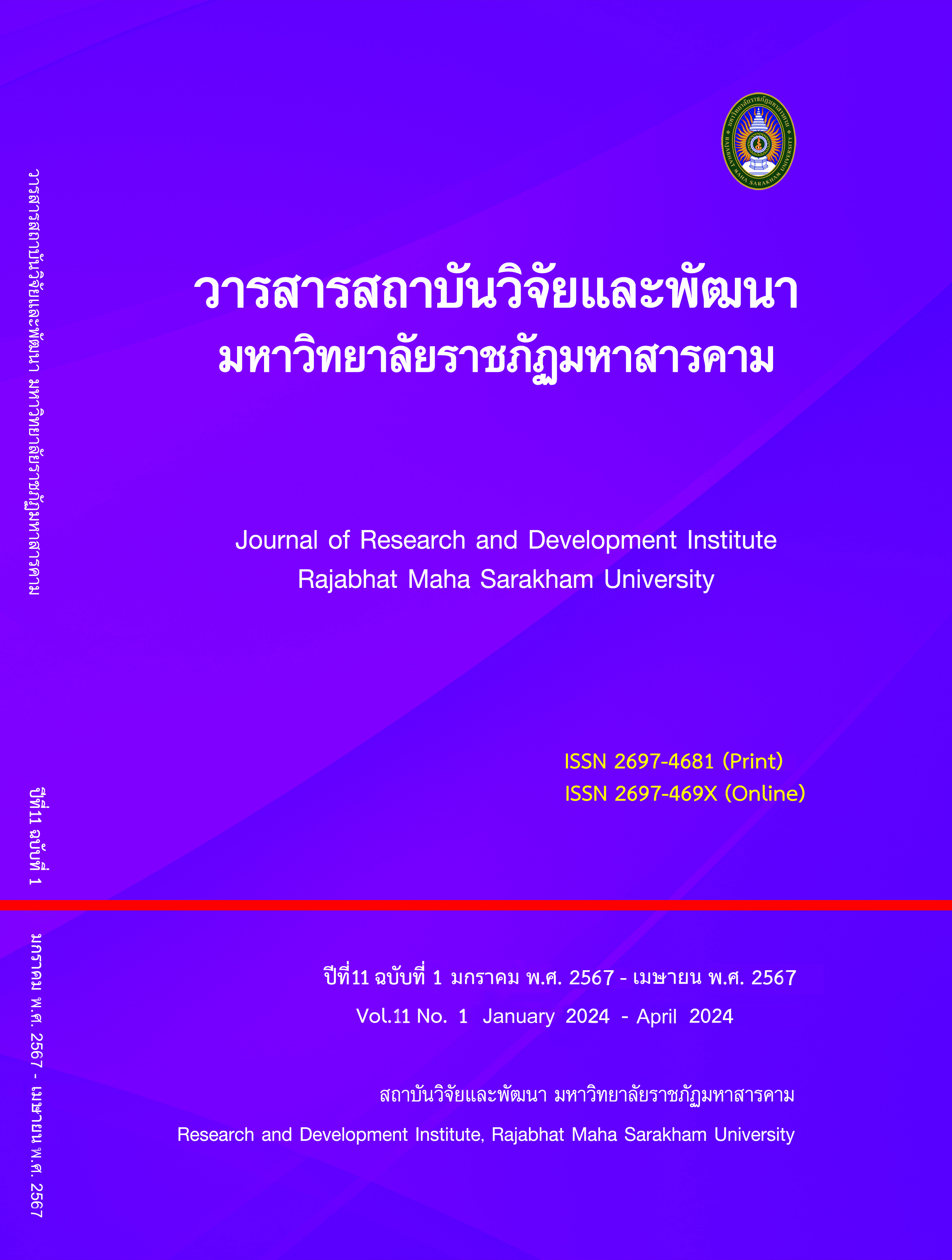Classroom Research on “Analysis of Creative Works of Journey Literature Written by the Third Year Students Majoring in Thai in the Second Semester of the 2022 Academic Year, Faculty of Education, Mahasarakam Ratjabhat University”
Keywords:
Analysis, Creative work, Journey literatureAbstract
Analysis of creative works from learning is an important issue which will provide us some understanding on development of the learners and it is the inspection of learning management to be used as a case study for further improvement. This Classroom Research on “Analysis of Creative Works of Journey Literature Written by the Third Year Students Majoring in Thai in the Second Semester of the 2022 Academic Year, Faculty of Education, Mahasarakam Ratjabhat University” current study aimed to analyse the contents of creative works of journey literature which are divided into four topics; thinking about what is loved, getting to know the places, ways of living, thoughts and events which aimed to analyse aesthetics of creation of journey literature which are divided into three topics; creation of sensation, sound setting and comparison of meanings. The samples of the study are 25 stories of journey literature written by the 25 third year students majoring in English, Faculty of Education, Mahasarakam Ratjabhat University, who registered in the course of journey literature in the second semester of the 2022 academic year.
The findings of the study are as follows:
1.Regarding the content analysis and from the analysis of all 25 stories of journey literature, it was found that the presentation of the creation of the stories in all perspectives according to the frequency of the creation covers 75 times of pondering of what is loved, 106 times of thinking of places, 57 times of thinking about life and 59 times of thoughts and events. This indicates that the students give their priority of their writing on observation and taking data from the places as their presentation. Specially, they showed their ideas about the CORONA VIRUS 19, talking about the contexts of society, economics and politics. The critiques on the works of the government were found in many journey stories which reflect that current students and new generation dare to show their ideas with more concerns on public.
- Regarding the analysis of aesthetics and from the analysis of all 25 journey stories, it was found that the creation of taste which was most frequent was “the taste of love” which occurred for 89 times. The subsequent occurrence was “the taste of sorrow” which occurred for 34 times. This indicates that the students had knowledge and understanding on the process of describing journey stories which focus on the emotion of love as the main stream and when people have to depart from their beloved ones, they always have sorrows. Therefore, the occurrence of the words indicating sorrow in a subsequent order is regarded as the concurrence with the presentation technique according to the style of the journey stories. Regarding the sound setting, there was the most use of sound concurrence for 2,290 times which was regarded as the basic skill in writing a poem. In a subsequent order, there was the use of consonant concurrence for 350 times which indicates that the students had a skill of using words and gave an importance on increasing the melody of the poem verses. Regarding the comparison of meanings, there was the most use of simile for 89 times which appeared in all stories of journey literature. It is noted that the rhetoric style of the comparison is a style which is widely used even in the daily life when people need to indicate something or it is easy for understanding its style. Next, there was the use of exaggerated words for 48 times which is the expression of much feeling about loving emotion which can not be replaced by real words (reality).
The results of the study revealed that the students understood the concept of journey literature and created skills from learning poetry writing in a satisfactory way.
References
Chiwapan, A. (2004). Language teaching. Bangkok : Chulalongkorn University.
Choktaweekij, S. (2017). Analysis of meaningful sounds in literature: A case study of Nirat London. Journal of Language and Linguistics, 35(2),45-76.
Eka, S. (2019). Teachers don't die. Bangkok : Good Head Printing & Packaging Group Co.,Ltd.
Nissa, P. (2022). Nirassida: The tradition of lamentation according to Sanskrit literary theory. Parichart Journal, 33(2), 93-106.
Office of Academic Promotion and Registration Nakhon Ratchasima Rajabhat University. (2011). Manual for developing and improving curricula according to the National Higher Education Qualifications Framework. Nakhon Ratchasima : Nakhon Ratchasima Rajabhat University.
Pattamalangkul, N. (2018). Complexity of genre and debate. About eternity. Journal of Thai Studies, 14(1), 61-78.
Phongsriwat, J. (1999). University libraries. Chiang Rai : Chiang Rai Rajabhat University.
Rakmanee, S. (2008). Literary language. (3rd ed). Bangkok : Kindness.
Tochayangkun, P. (2018). References to literature in Thanthai in modern Nirat: continuation and creativity. Interdisciplinary Studies Journal, 18(2), 88-111.
Vongkrabakthaworn, S. (2017). Nirat Literature: Studies to enhance intellectual tourism. Maha Sarakham : Apichat Printing.
Downloads
Published
How to Cite
Issue
Section
License
Copyright (c) 2024 สุทัศน์ วงศ์กระบากถาวร

This work is licensed under a Creative Commons Attribution-NonCommercial-NoDerivatives 4.0 International License.
Articles that are published are copyrighted by the authors of the articles






